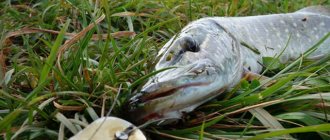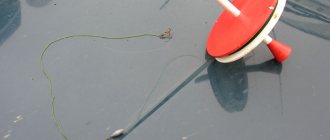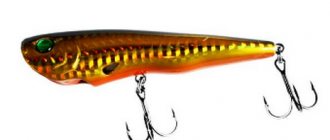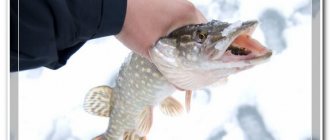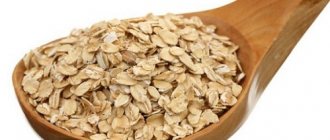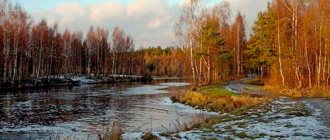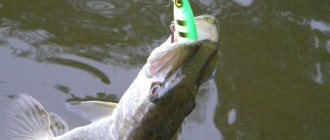To successfully catch pike in April using spinning rods and other gear, it is important to take into account the peculiarities of the spring behavior of the predator. In addition, depending on the region and the speed of spring, changes in the toothy behavior occur from year to year at different times. Pike can be caught in April, but not everywhere and not always. In some regions this is ice fishing, in others it is post-spawning activation of the bite. Let's take a closer look at how to catch pike in April using spinning rods and live bait gear, and where to look for pike in reservoirs.
Pike after spawning
When considering fishing for pike in April using a spinning rod, we will rely not on calendar dates, but on natural ones. In the northern regions, and in the cold winter in the middle, southern regions, in early April, reservoirs may still be covered with ice. Then winter fishing is still going on. You can go fishing for pike with poles and gear for winter trolling. This issue is covered in detail in the article on fishing for pike in the spring from ice
In the north of the middle zone, in Siberia, and also when spring is late, fishing for pike in April with a summer spinning rod is possible in the upper small rivers, if it is still cold, the water is clear, and there is no ice. This period coincides with the beginning of the activation of pike and its movements to spawn. If there is no ban in this particular region, and you hit the time window, you can catch the pre-spawning feast. However, even if there is no ban, the caviar pike must be released - we are not dying of hunger. The pre-spawning period for pike fishing in open water is discussed in the publication about fishing for pike with a spinning rod in March
By spring fishing for pike in April we mean the period of fishing for toothy pike after spawning - turbidity and rising water, shallow bays with depths of up to 1.5 meters and grass, then clearing of the rivers and post-spawning activation of the bite. Somewhere in the south this period may occur in March, and in the north – in May days. To understand this, it is useful for the angler to understand the general picture of pike behavior in the spring
You need to rely not on the calendar and specific dates, but monitor the weather and the speed of the onset of spring. Pike spawns early - at a water temperature of 5-7 degrees. Toothed caviar needs clean and oxygenated water to develop. Whether pike bite in April specifically in your area - see for yourself, depending on local conditions, prohibitions and the speed of the onset of spring. At the moment of spawning, the pike is not caught. And there is no need to prevent her from giving offspring.
After the pike spawns, a week or two usually passes, then the toothy one becomes more active and begins to regain strength after spawning. Just in time for the overgrown shallow waters where she rests, during this period the white fish begin to approach to also spawn. In places along the thickets of the coastline and in shallow bays where the predator has recently spawned, crucian carp, roach, silver bream and all other whitefish begin to concentrate. And greedy toothy jaws are already waiting for this movement.
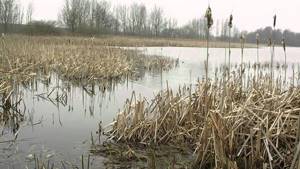
How to catch pike with a spinning rod
The peculiarities of catching pike with a spinning rod in the spring are determined by two factors: its activity and movement through the reservoir associated with warming up the water and spawning.
Fishing from the shore on the river
As already mentioned, in the spring the pike comes to shallow coastal areas, so when fishing from the river bank, it is necessary to fish for them. You need to be prepared for the fact that often, especially on steep banks, it can stand right under the shore, and a bite can occur when the wiring is completed. Therefore, in the spring, wiring must always be actively completed. It is often effective, on narrow rivers, to cast bait under the opposite steep bank while on a flat bank.
The bite can occur when the bait is immersed immediately after falling or at the beginning of the retrieve. Throwing and guiding along a steep bank are also effective. In spring, the pike is weakened, so you should not look for it in the current and adjacent areas.
From the boat
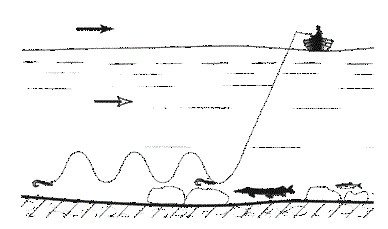
When planning to go fishing from a boat in the spring, you must first take into account whether the ban on fishing in open water is currently in force. In many regions, such a ban exists from April to May inclusive.
When fishing from a boat, shallow waters are fished, and when fishing along the shore, areas with shallow depths, up to 1.5 meters, and the presence of shelters are selected. It is often worth walking along the steep bank. Since the boat does not require long casts, in the spring it is better to use light one-handed spinning rods with good sensitivity.
On the lake
Since there is practically no current on the lakes, pike can be found almost throughout the entire water area, so the fishing location must be chosen depending on the period of the season. In early spring, on deep-water lakes, it will be on the shallows along the shore. On shallow lakes it is worth looking for it in small areas not only under the shore, but throughout the entire body of water. As it warms up, the predator will go deeper and deeper.
Important! Knowing the bottom topography is very important when fishing for pike. Even in shallow water there can be holes, ditches and mounds; all of these can be places for pike to stay.
On the pond
In ponds, due to the small water area, the water warms up quite quickly. Therefore, there the pike almost all the time stands in the places of their usual ambushes, and these areas practically do not change throughout the year.
Pike in muddy water after high water
The fisherman’s goal is to find quiet places where the pike has gone to spawn. After spawning, she rests there or somewhere nearby. On even, powerful riverbeds, where the ice drifts through everything with slush like a file, there will be no predator - after all, the eggs will not survive here. In rivers, we focus on branches from the channel, bays and upper reaches with tributaries.
If the water has already risen and the temperature is already spawning, the pike will spawn in warm, calm water meadows. As the water recedes, the hatched larvae will squint. Such points need to be checked, if not prohibited, while waiting for the activation of the bite after the spawn. Even if this flooded swamp becomes shallow, the pike will be somewhere further, in the bushes on the border with the main water.
In early April, pike, as a rule, if the spring is warm, spawns earlier in small rivers. And at this time, sometimes it begins to be caught. In ponds and lakes that warm up later, the predator becomes active later. Fishing for pike in April with a spinning rod on small rivers is either pre-spawning fishing in cold, clear water (see the link about March fishing), or the off-season and high water without biting, or a period of recession and clearing of the water - this is what interests us. We are waiting for the pike to start biting - we check the bays, the coastal zone near the reeds with depths of about a meter and young seedlings of aquatic vegetation.

- On some rivers, spring pike fishing in April involves searching for predators in muddy water. If the channel is the same, there are no bays or shallow waters, then local pike will spawn in the coastal zone. It will remain there if the water is not too dirty.
- Fishing for pike in high water and in muddy water, if there are no calm bays with relatively clean water areas - search for local nooks and shelters. Around turns, snags, under underwater cliffs, fish gather, hiding from dirt particles that settle on the gills and interfere with breathing.
- Naturally, the fish does not stand all the time. In April, the reservoir is teeming - everything is moving somewhere. At this time, the pike has usually already spawned, and in ambushes it stands in relatively clean and quiet places - you can see better here.
- Spinning lures for catching pike in the muddy waters of high water must play well on a slow retrieve so that the pike can notice them and have time to grab them. Therefore, it is better to give preference to wobblers with rattles and sweeping action, amplitude spinners and spinners with a willow leaf petal.
- They need to be carried out pointwise in front of local shelters - return paths behind a cape, a bush, a calm break area behind a log or sediment, in a pocket of reeds. It is useless to look for pike in the current or depth itself. In relatively clean thickets, any bait works - here the toothy fish sees and controls everything from afar.
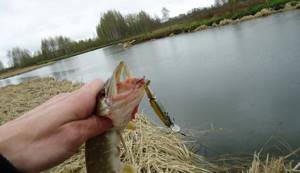
Fishing for pike in the spring using a spinning rod
With the first harbingers of spring warmth, large fish hunters become more active, buy and restore to a functional state spinning rods that have been “resting” in garages all winter.
Fishing for pike in spring often brings good luck to both experienced fishermen and beginners. But still, some subtleties associated with the choice of terrain, fishing rod, and bait need to be known thoroughly. To do this, many sites have a video review that clearly demonstrates the principles of handling spinning rods and bait. Fishing for pike in the spring using a spinning rod begins after the complete disappearance of ice from the surface of the reservoir. The bite in March, April and May is much better than in summer. But the right equipment still plays a key role.
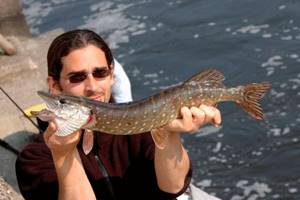
In spring there are two periods when pike are interested in fishing baits:
• zhor before the ripening of caviar;
• increased appetite after spawning.
Both periods of time fall on the days of all three spring months.
For pike in March
When March comes, the famous predator leaves its hiding places in search of good food before spawning. At this time, any bait that the pike will definitely attack is suitable for it:
• wobbler;
• twisters;
• oscillating spoon;
• vibrating tail.
In March, pike during the daytime prefer creeks without a current with snags and large algae. Small white fish are concentrated here and are hunted by predators. If the fisherman went out with the boat in the evening, then after the pike it is necessary to move to places with great depth as far as possible from the coastline.
For March fishing, it is better to choose a graphite spinning rod with a light rod. For experienced fishermen, a high-modulus carbon-plastic fishing rod is suitable.
The predator's desire to prey on everything increases as atmospheric pressure decreases. Many people make the mistake of packing up their fishing rods if the weather starts to turn bad. In cloudy weather, the predator's bite can be doubly great.
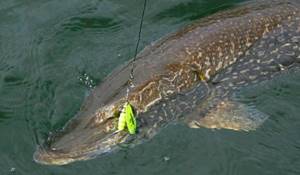
For novice fishermen, the Japanese Joy Spin spinning rod models with a test weight of 10-30 g will be easy to operate. Okuma RTX 30. The test is a numerical indicator indicating the minimum and maximum weight of the bait. A bait whose weight is no more and no less than the range recommended by fishing rod manufacturers is optimal for convenient and effective fishing.
The length of the spinning rod should be 2.5-4 m. To catch pike alone, it is better to take a short fishing rod, but if you have someone to hook and pull out a bite, a three-meter spinning rod will be just right.
Pike in April
April includes the spawning period for pike. The possibility of a ban on catching predators should be clarified with the fisheries industry in your region. At the end of the spawn in the area where the pike lives, the fisherman can get close, the fish will not be afraid.
Fishing will be effective with a two and a half meter long spinning rod from a boat and from the shore. The weight of the wobbler varies from 10 to 20 grams.
For larger oscillating spinners, the spinning rod test is 30-40 grams. The rod reel should not contain any frills and have the following functions:
• smooth running;
• friction brake;
• fast winding ability.
It is better to select the strength of the fishing line with the highest strength, since the April pike has the sharpest teeth. To avoid “cutting”, experienced fishermen use tungsten and steel leashes. They are also made from guitar strings. A loop is wound at one end, and swivels are formed at the other end to secure the bait.
Fishing for pike in May using a spinning rod
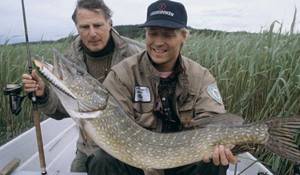
May gives the predator after spawning a wide choice of food (fry, toads, white fish). But in the middle of the month - the period of zhora after spawning - fishing for pike in the spring with a spinning rod remains favorable until the beginning of summer. At this time, the predator chooses areas where it sits out until the onset of hot days.
However, in late spring, the period of spawning and spawning can last until mid-May. There is a ban on pike fishing in some areas, but this may be extended this month.
Where there are places where clean water and river turbidity mix, there is a chance of catching pike, since it chooses food from the turbid environment.
When choosing a spinning rod, the rules for fishermen are the same as in previous months. Lures are used based on the conditions of the reservoir (the most effective wobbler, as well as spinners and jigs). It is advisable to purchase a spinning rod with a length of 2-2.5 meters. The optimal reel sizes for May fishing vary in the range of 1000-2500 cm. Braided and monofilament fishing line is allowed.
Jig bait works well in the absence of current. Wobblers are useful in shallow areas of rivers.
Among the best manufacturers of such baits are:
• Rapala X-Rap;
• Lucky Craft;
• Evergreen Side Step.
The means contribute to the effective fishing of large areas of water. In May, the predator notices a spinner bait at medium and great depths. Their sizes are indicated by a number. Optimal for catching pikes are No. 1-3, and 2-5. The brighter their colors, the greater the chances of a fisherman sitting on the shore or in a boat to attract a predator.
Fishing in bays
If the rivers are a rushing stream, it is better to focus on ponds or spills in the upper reaches, where the water is much cleaner and calmer. Flooded reeds in the upper reaches of ponds, rivers, and lakes are the best spots for pike fishing in April. It spawned here some time ago - and will immediately begin to eat the white fish that come into the same waters.
Pike on the rivers in April with a spinning rod, if the time coincides - also primarily fishing for reed bays, windows, borders with the main channel. All the fish will concentrate here at this time. Pike is not a schooling fish - but in April it gathers together to spawn, and then continues to feed right there until the final warming and the water goes into the shores. Therefore, there may be many pike individuals in one promising place.
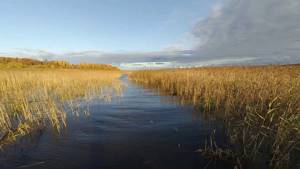
In April, pike can also be caught on lakes using spinning rods - if the ice has already melted, the temperature has risen and spawning ended more than a week or two ago. Here you also need to look in the upper reaches and near flooded banks. If external signs show that there is fish (any kind) here, then the pike is somewhere nearby, resting and hunting from time to time.
- Pike's zest after spawning usually occurs in the so-called warm April - when the sun is already warming up, it is quiet and warm, the water is cleared and begins to warm up - in the range of reservoir temperatures from 7 to 12 degrees. Just when roach, crucian carp and other whitefish are already arriving in large numbers in the bays. The timing differs on each specific reservoir, and from year to year as well. You need to focus on nature, and not some fictitious biting calendars.
- In overgrown bays it is more convenient to fish from a boat or wade in waders or the lower part of the OZK. Of course, if it is not prohibited by the rules. We fish the windows between the reeds, the border with open water, and the entire coastal strip of vegetation. We experiment with baits. On the bushes themselves - non-hooking baits, spoons with chipper hooks and spinnerbaits. With further warming, it may begin to actively fish for poppers, walkers or Croatian eggs.
- If the water is cloudy, pike attacks in April will be short, no more than two or three body lengths of the hunter. Then we apply the general rule for muddy water. You need a noticeable bait - bright, white, noisy, and on a slow retrieve, but at the same time create powerful vibrations. Therefore, in such conditions, small noisy minnows, shads or crankbaits of white or light green color work well.

Catching pike in spring from a boat
Having a boat allows you to fish a significant part of the reservoir. For small rivers and ponds it is not needed, but in spacious water areas it will be a good help for the fisherman. The boat makes it possible
:
— choose the most convenient place for casting;
— protect baits from snags;
— explore areas remote from the shore.
You can use the boat before and after fish spawning. It is enough to simply swim to the border with aquatic vegetation, to the shallows, and begin exploration from the side where the open water begins. Then gradually move to other places where the predator can live in the spring. There is a good bite in April during the day, and by the end of May - in the early morning and evening. The first hour and a half of fishing makes it clear how active the pike is. The release of a predator can happen at any moment. Then you need to immediately use more aggressive baits.
The most promising fishing is if the boat is anchored at a distance of 15 to 30 meters from the shore and casts to the water's edge. In the spring, pike often begin to hunt for frogs and turn their nose to the shore, so this method of fishing gives good results.
Recession of water and warming
The pike bite in April will stabilize as the water becomes clearer and warmer. Cyclicity appears in the toothy behavior. We continue to look for pike in April in shallow waters and bays, as well as near local disturbances in the relief on small rivers. It's not just pencils that are caught in shallow waters in the spring. The trophy pike is also here somewhere - it eats off after spawning and has not gone to its summer camps.
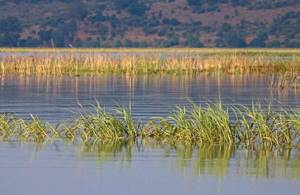
The warmer it is, the more obvious the division of the bite into morning and evening. With the final shallowing of the bays, the pike moves further - to depths of about a meter. Pike fishing at the end of April in the south is full-fledged May fishing, when the predator can be found in its usual summer places. The toothy one begins to actively take surface poppers and walkers, respond to faster retrieves of spinners and twitching of wobblers. More information about fishing for pike with a spinning rod in May
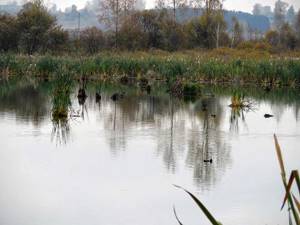
Bait
When, after a cold winter, the reservoir becomes warmer every day, the pike also becomes active. At the end of April, in some reservoirs you can catch it all day, resting only at night. Moreover, it will bite both live bait and artificial bait. When fishing with roach, silver bream or bleak, the bait should be placed in half-water or even a little deeper. Pike can be caught well in April using spinning rods in shallow coastal waters. In this case, the size of the live bait does not play a special role, but it is still better to use medium-sized fish with a length of five to ten centimeters.
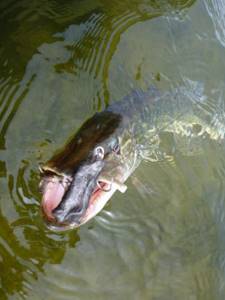
Spawning ban
The timing and nuances of the ban on spring pike fishing differ depending on the region. It is necessary to clarify specifically by region and fishery basins - each has its own law on fisheries.
For example, in the Azov-Black Sea basin there is a complete ban on pike fishing from January 15 to March 1. In April, general spawning bans already begin to apply. The deadlines are set for each section of the pool separately. Wading and fishing from a boat is prohibited everywhere. But in terms of gear, depending on the regions, the specifics of the prohibitions differ. Here you need to look specifically at the articles with reference to the location.
In some regions you can fish with a spinning rod without restrictions, in others it is not possible, only with a fishing rod or donka with one or two hooks. Thirdly, it is possible, but only with one hook, so on wobblers you have to remove one tee. If fishing with a spinning rod is prohibited, but the pike bites, and there is no ban on it, then you can concentrate on fishing with a rod or donka, with live bait. Mugs - flying is prohibited, as it is not allowed on a boat.

Spinning baits in April
The eternal question is what to use to catch pike in April. Don’t look for any special April baits – they don’t exist. Nobody buys wobblers or spinners specifically for time periods. In cold and often muddy water, the principle is the same. Slow retrieval, the bait is noticeable in appearance and noise, but at the same time there is a clear game. And we select any spinners, wobblers or jigs to suit this trend. Naturally, the picture on a pond during a particular fishing trip can be exactly the opposite - this is fishing. The approach to lures for pike fishing in April is the same as always - we search, experiment, select.
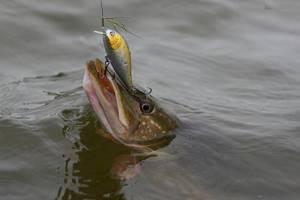
Wobblers
You can catch pike in the spring in April using any wobblers - it’s a matter of selection on the reservoir. But the general trend continues. You will need baits that do not go too deep - about a meter or surface ones. Fishing is mainly done in bays or in shallow waters near the reeds. Therefore, rudras, rerenjis or balisongs are not suitable. Well, only in a floating version without deep penetration.
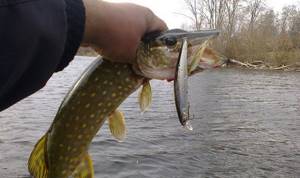
It is better to focus on wobblers for pike with a depth of no more than 1 meter. In clear cold water you need baits with their own active action, small minnows, shads and or cranks. The warmer it is, the more active the pike is, and the better it responds to vigorous twitching. In muddy water there are noticeable colors, mat tiger or watermelon, yellow-green acid. In clear water, passive fish have natural, nondescript colors. If the weather is good and the toothy fish are active, bright and noisy wobblers can work in cold water in early April.
In overgrown bays, especially if you cannot wade or use a boat, when fishing for pike with a spinning rod in April from the shore, it is better not to use wobblers - there is a high probability of getting caught and losing the bait. In this case, it is better to use a jig mounted on an offset machine or without hooks. If the bay is clean, with only soft mud, we also use wobblers.

Jig
Jigs also work - these are baits not only for deep water. If there is a high probability of a hook, we use a hinged mounting with an offset in the body of the bait. In shallow water and in the grass - an unweighted jig. In the thickets, a step is problematic - but this is not necessary here. Slow, steady tapping of the bait on the reed stems is the best way to catch pike in such a place.
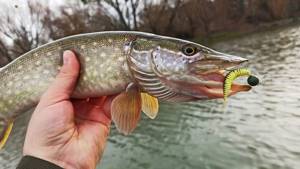
In mid-April, if it is already warm, pike can be found not only in shallow waters, but also in depths of up to 3 meters on the approaches to them. In reservoirs where there are simply no bays or thickets, we usually search along the shore edges and irregularities - here we use a classic jig for pike. The step you need is not very active - small twitches with pronounced pauses are better. In small rivers, a good tactic is precise casting under local cover. Here you can often take a pike on the first fall of the bait. We select silicone according to shape and size - twisters, vibrating tails, crustaceans. We are also experimenting with color - both dark tones like machine oil and bright ones - yellow, orange, red - can work.
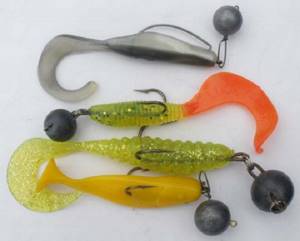
Spoons
In the spring, pike take spinners and spinners in April - we use ordinary spinners and spoons. Spinner spinners in cold water - with a long blade, on a slow retrieve on the verge of breakdown. We also move the oscillators slowly, trying not to create parasitic unnecessary vibrations. With a wave we are looking for wiring - uniform, wavy, to fall near the shelters.
In thickets, we equip the spinners with an offset rig with a twister or antennae on the tee - we turn it into a non-hooking one. This is better than buying incomprehensible special non-hooking hooks, which do not know whether they catch fish at all. Article - the right lures for pike
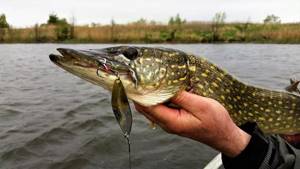
Surface baits
If it is warm and the water is already clear, from mid-April pike can begin to take poppers and other surface baits. We check such deceptions first of all if the weather is calm, warm and sunny. We try to move the poppers or Croatian egg slowly and with even pauses, with small splashes, so as not to scare the still nervous pike. More about catching pike with poppers
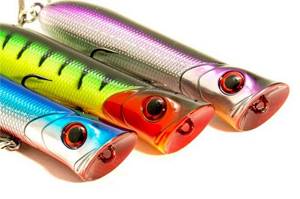
Spinning
This kind of fishing does not require any expensive specific gear, the main thing is that it is durable, because the pike rests with dignity. Now fishing stores offer a very wide range of spinning rods for catching predatory fish, so there will be no problems with the choice. This is for beginners, but experienced spinning anglers already have in their arsenal fishing gear sharpened for pike. As a rule, this is a universal, well-balanced spinning rod with a length of 2.4 meters, which is convenient for fishing in different conditions. Its sensitive tip transmits even weak contact between the bait and the fish, and the thin cord allows you to cast far and fish promising areas located far from the coastline. The reel used is inertia-free, with easy movement and a correctly adjusted clutch (clamped by 85-90%).
As for baits, in mid-spring, silicone vibrotails, twisters and slugs, especially edible ones, which contain attractants, have proven themselves to be the best. Their advantage is not only high efficiency, but also the ability to fish in difficult places where a regular spoon will not fit. For such places, a movable installation “Cheburashka + offset hook” is suitable. The sting of the latter is hidden in the body of the soft bait, which significantly reduces the risk of a dead hook.
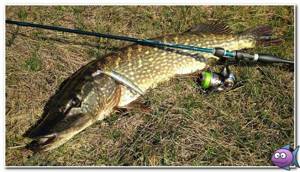
In relatively clean areas you can fish with oscillating spoons, spinners and wobblers. As mentioned above, after spawning, the toothy one takes on almost everything. In any case, the arsenal of baits should not be meager, otherwise there will be nothing to experiment with. It is thanks to experiments with baits and methods of presenting them that fishing for pike in April with a spinning rod becomes an exciting and productive activity.
Fishing for pike in April with live bait
If there is no ban on boats, you can fish with mugs and stands on poles. We choose small and narrow-bodied live bait. Naturally, we install live bait gear in the places described in this article. First of all, these are quiet shallow areas near the thickets, windows among the reeds, and bays overgrown in summer.
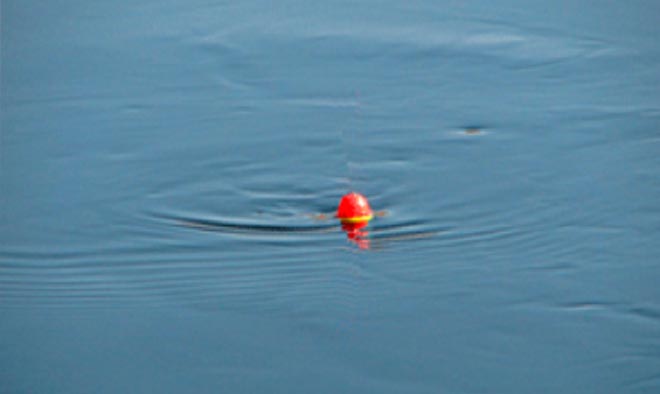
Catching pike during a flood with live bait with a float rod directly on the riverbed in muddy water will most likely not bring success. It is better to place a fishing rod with fry in quiet, clean, local shelters, or in the same bays. It makes sense to fish with bottom gear and rubber bands on already cleared rivers and ponds, where there are no pike bays, and you just need to fish from the shore along shallows and banks with a dump into the riverbed.
